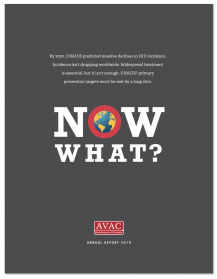Emily Bass is AVAC’s Director of Strategy & Content.
The three-week PEPFAR Regional Planning Meetings (RPM) wrapped up last week. Each week two included a fresh group of countries, some familiar patterns and some new ideas. You can check out a write-up of the first week here. One of the most important takeaways to consider is the need for ongoing attention to this work. It can’t be contained within these few weeks—PEPFAR engagement is a 365-day effort, and the wins at the RPM are sometimes fragile. Just one week removed from their COP review, Tanzanian activists went into action after language in the government’s circular on forced anal exams didn’t have a clear prohibition, as promised at the RPM, of the practice. And in Malawi, once activists, government and PEPFAR got home, conversations about seemingly settled issues continued. This isn’t a problem—it’s how the process works, and it’s why the work continues after the RPMs. Here are some additional areas to celebrate and watch with vigilance.
A View from the Zimbabwe Room: Preserving primary prevention, speeding TLD transition
Going into the RPM, Zimbabwe’s lean US$145 million program – as compared to, say, Kenya’s US$350 million program – wasn’t facing any cuts, but its funds were largely consumed by antiretroviral treatment and programming for orphans and vulnerable children (OVC). Growth seemed off the table, and by the end of the week both DREAMS and voluntary medical male circumcision (VMMC) – both key prevention strategies for AGYW and men respectively – faced US$2 million cuts. Zimbabwean civil society, represented by Diana Mailosi of Advocacy Core Team (ACT) and Walter Chikanya of Zimbabwe Community Health Intervention Research (ZiCHIRe) presented priorities developed via in-country consultations—many previously shared with PEPFAR. [The ACT is a key Zimbabwean partner in the Coalition to build Momentum, Power, Activism, Strategy and Solidarity (COMPASS Africa)—learn more about this work here]. These priorities included expanding the coverage of viral load testing; protecting and expanding VMMC; differentiated service delivery and accelerated transition to dolutegravir for treatment, also known as TLD transition. Advocates also pushed for the cuts to DREAMS and VMMC to be rescinded, and those dollars were restored to the programs.
After a week of public negotiation in the Zimbabwe room and in side-discussions, civil society also ensured a commitment to include screening for intimate partner violence (IPV) in all index-testing programs, a PEPFAR intervention to increase identification of people living with HIV. IPV screening is a key step to protect individuals who are asked to disclose their sexual contacts, biological children and needle-sharing partners as part of index testing.
In these meetings, other stakeholders make commitments, too, in response to advocates calling out gaps. This year, the Global Fund to Fight AIDS, Tuberculosis and Malaria (GFATM) stepped in with approximately US$5.5 million for viral load reagents. This became a priority as it became clear that without such a commitment, viral load testing would cover only 60 percent of those eligible. Activists also helped to win accelerated TLD transition, now set to occur in nine months rather than one year, and the Ministry of Health representative from Zimbabwe outlined an approach that centers on women’s choice—so that women of childbearing age who wanted to opt for DTG can do so whether on contraception or not. These are big wins and require ongoing vigilance from in-country advocates to ensure that providers, women and all PLHIV have robust treatment literacy and that the shelves carry the options for contraceptives and antiretrovirals needed to make informed choice a reality.
A Return to Treatment Literacy: It’s about time
The discussion of the Zambia program looked at many issues—including struggles with retention in treatment among certain age groups, persistently low rates of HIV testing within key population programs, and the need for programs to deliver condoms, lubricant, oral PrEP and more while protecting human rights, safety and security. For many in the room—which included Enock from Friends of Rainka and Fred from Network of Zambian People Living with HIV—one key win was the strong commitment to expand treatment literacy at antiretroviral treatment (ART) sites and in the community, led by and for people living with HIV. So many of today’s programmatic interventions, from index testing to TLD transition to PrEP uptake are best delivered with the support of peers who can provide correct, comprehensive information. This “treatment literacy” was once a mainstay of AIDS treatment—but funding for it fell by the wayside as ART clinics got medicalized, and it seemed a matter of just prescriptions and refills. It was never this simple; and today, countries and programs are finally returning to a fundamental element of truly effective public health programs: information from, by and for the people who are the true experts.
What’s Next
COMPASS coalitions in Malawi and Zimbabwe are following up and nailing down the fine points; in Uganda, HEPS, a longtime AVAC collaborator, is finishing up a report on how civil society can participate in PEPFAR’s site-level monitoring work, known as “SIMS”—a critical way to keep tabs on what is actually happening on the ground. Look for that report in the coming months. We’ll announce it on the P-Values blog, and you’ll be able to find it on avac.org/high-impact-prevention.
We’ll also be closely following developments in so-called “reboot” countries, where the Office of the Global AIDS Coordinator (OGAC) is demanding wholesale overhauls of the programs before any money gets spent. Mozambique, South Africa and Tanzania are all in this category; likewise, the transition to “indigenous” partners—local organizations versus international NGOS—will be something to track to ensure that resources go to groups with ground-level expertise, proven track records and the ability to deliver.
We’ll be watching—will you?
